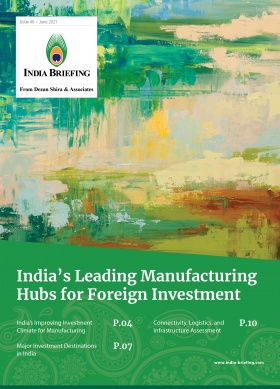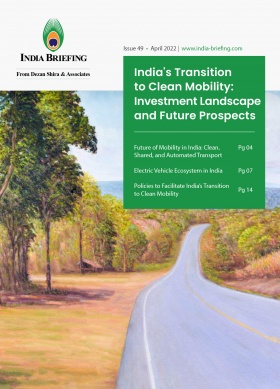India PLI Scheme for Design-Led Manufacturing of 5G Products
India amended its PLI scheme for telecom and networking products to include design-led manufacturing of 5G products. The expanded PLI scheme closed for applications on August 25, 2022. The Department of Telecom (DoT) received 32 applications as of deadline. Among new notable applicants to the telecom PLI scheme is Samsung, which seeks to manufacture 4G and 5G telecom equipment in India for sales in the domestic market and overseas. Leading global firms like Cisco, Jabil, Flex, Foxconn, Nokia, and Ericsson have also applied to the amended PLI scheme.
The amended PLI scheme will facilitate design-led manufacturing and offers an additional incentive rate of one percent over and above existing incentive rates; a portion of INR 40 billion out of the scheme’s budgeted INR 121.95 billion has been set aside for it.
There are 11 new telecom and networking products under the amended scheme.
Further, the DoT extended the PLI Scheme by one year as many companies have suffered due to COVID-linked disruptions. Beneficiaries can choose the financial year 2021-22 or financial year 2022-23 as their first year of incentive and can claim benefits for only five years.
To facilitate design-led manufacturing of 5G products in India under the Production Linked Incentive (PLI) Scheme for Telecom and Networking Products, the federal government has amended the existing PLI scheme to extend its scope as well as timeline.
The new amendments to the scheme, which were notified by the Department of Telecommunications (DoT) on June 20, 2021, have been instituted based on a proposal for the same in the Union Budget 2022. The objective is to build a strong ecosystem for 5G in India.
Earlier in February 2021, DoT had notified the PLI scheme for the telecom sector with a total outlay of INR 121.95 billion. In October 2021, a total of 31 companies, comprising 16 MSMEs and 15 non-MSMEs, including eight domestic and seven global companies, were approved as beneficiaries.
Application process for the amended PLI scheme for telecom and networking products
The application window was open from June 21, 2022 till July 20, 2022, and the extended twice, to August 5 and finally, August 25, following the government’s successful 5G spectrum auction.
The investments can be made in the scheme’s target segments under the following categories:
- Plant, machinery, equipment, and associated utilities
- Research and development (R&D)
- Transfer of technology agreements
The incentives will be funded from the remaining amount of the PLI scheme’s total outlay of INR 121.95 billion, that is INR 40 billion.
Applications submitted as of close of deadline
As per an official release, as many as 32 companies (22 MSMEs, five domestic non-MSMEs and five global) have submitted applications for Design-led Incentive Scheme (DLI) and PLI scheme of telecom. While 17 of these 32 companies have applied as design-led manufacturers, remaining have applied as production linked manufacturers.
Among new notable applicants to the telecom PLI is Samsung, which seeks to manufacture 4G and 5G telecom equipment in India for the first time – targeting sales in the domestic market as well as overseas. Other leading global firms who have applied to the amended PLI scheme, are Cisco, Jabil, Flex, Foxconn, Nokia, and Ericsson.
Changes in the amended PLI scheme for telecom and networking products
Extension of timeline
Based on feedback from stakeholders, including the selected PLI applicants, the base year for the calculation of incentives for the PLI scheme on telecom equipment has been extended by one year. The applicants can now choose between financial year (FY) 2021-22 and FY 2022-23 as the first year of incentive. Earlier, FY 2019-20 was fixed as the base year. The benefits can be claimed for five years.
New design-led manufacturing scheme under the PLI scheme for telecom and networking products
The government opened applications for design-led manufacturing under the amended PLI scheme for the telecom sector. This is mainly intended to support efforts for designing telecom products in India. It will recognize and encourage R&D driven manufacturing to augment the sector’s contribution to the global value chain as directed by the National Digital Communication Policy, 2018.
As per the amended scheme, eligible applicants can avail incentives for five years starting from April 1, 2022 up to FY 2025-26, subject to qualifying incremental annual thresholds. The DoT had specified that applications for design-led manufacturing would be given preference over other manufacturers in the shortlisting process.
The design-led manufacturing scheme was open for both medium and small-scale enterprises (MSMEs) and non-MSMEs, including domestic and global companies. While the investment threshold is fixed at INR 100 million for MSMEs, non-MSMEs require a minimum investment of INR 1000 million. Land and building cost is not be counted as investment.
If a company was availing benefits under the pre-existing telecom PLI scheme, and they wanted to revise their investment plan and net sales to secure the additional one percent for design-led manufacturing, the company had to make a fresh application. Senior officials in the DoT mention that some existing firms have migrated to the revised design-led manufacturing scheme. If the company is selected under the fresh scheme, the existing approval will not stand and investment made in FY 2021-22 will not apply.
Incentives based on incremental sales
The incentives will be based on incremental sales of the manufactured goods, ranging between four to seven percent for different categories over the years. MSMEs will get an additional incentive of one percent in the first, second, and third years.
Changes to expenditure incurred on R&D
The amended policy includes the expenditure incurred on manpower in the capital expenditure incurred on R&D. Earlier these manpower expenses were excluded.
Changes made to expenditure related to transfer of technology clause
To incorporate the new design-led manufacturing scheme in the existing PLI telecom umbrella, this expenditure shall also include cost of technology and any technology purchase related to goods covered under the scheme’s target segments through government labs, academic institutions within India, C-DOT, or DSIR registered R&D entities.
Additionally, the expenditure cap of five percent of the total committed investment on transfer of technology earlier has now been eliminated.
Increased allocation for MSMEs
The maximum financial allocation for MSMEs over five years has been increased from INR 10 billion earlier to INR 25 billion under the amended scheme.
Approval for 11 new products
The DoT has also added 11 new telecom and network products to the existing list of products that can be manufactured under the PLI scheme. The additions have been made to the following categories:
- Core transmission equipment: Millimeter radio, E/V-band radios, satellite gateway equipment (hub/earth station), free space optics communications equipment
- 4G/5G, next Generation radio access network, and wireless equipment: telecom antenna, open-RAN equipment (radio unit, distributed unit, centralized unit and RAN intelligent controller)
- Access and customer premises equipment (CPE), IoT access devices: Internet set top box, satellite CPEs for accessing internet, VSAT equipment, NG-PON-ONT, telecom modules of IoT/M2M access devices
This article was originally published June 23, 2022. It was last updated August 29, 2022.
About Us
India Briefing is produced by Dezan Shira & Associates. The firm assists foreign investors throughout Asia from offices across the world, including in Delhi and Mumbai. Readers may write to india@dezshira.com for more support on doing business in in India.
We also maintain offices or have alliance partners assisting foreign investors in Indonesia, Singapore, Vietnam, Philippines, Malaysia, Thailand, Italy, Germany, and the United States, in addition to practices in Bangladesh and Russia.
- Previous Article India-Israel Bilateral Trade and Investment Trends
- Next Article How Businesses Are Expected to Gain from the India-UAE CEPA








